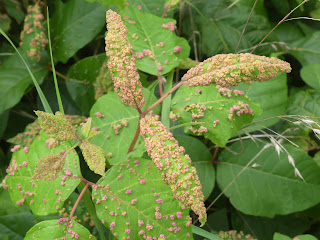Poison Ivy Leaf Mites
Last weekend at Duke Farms the Outdoor Education topic was "Nature's Nasties", mostly focusing on stuff to avoid like Poison Ivy, Stinging Nettle, and Deer Ticks [1]. We weren't exactly sure what to make of the pinkish growths on some of the Poison Ivy growing nearby. (While 1 of the staff theorized they could be some sort of galls - which turned out to be correct - some sort of fungus also sounded feasible.) Of course there's a natural reluctance to handle Poison Ivy to try and figure out what the stuff was, which didn't help the investigation.
After getting home, a quick search showed me a webpage with Poison Ivy with almost exactly the same condition, which they attributed to Poison Ivy Gall Mites. (FWIW iNaturalist uses the name Poison Ivy Leaf Mites.) Although I can't imagine that covering a leaf with these galls doesn't have some impact on Poison Ivy's ability to photosynthesize, this article suggests that the galls aren't particularly harmful to the plant [2].
 |
| July 15, 2023 at Duke Farms Photo 301282044, (c) jpviolette, some rights reserved (CC BY-NC) |
[1] In actuality all of these are native species that have a role to play in our ecosystem, but us humans would still benefit from avoiding them.
[2] If you're hoping to rid your yard of Poison Ivy by buying a bunch of mites, you're probably going to be disappointed with the results.



Comments
Post a Comment